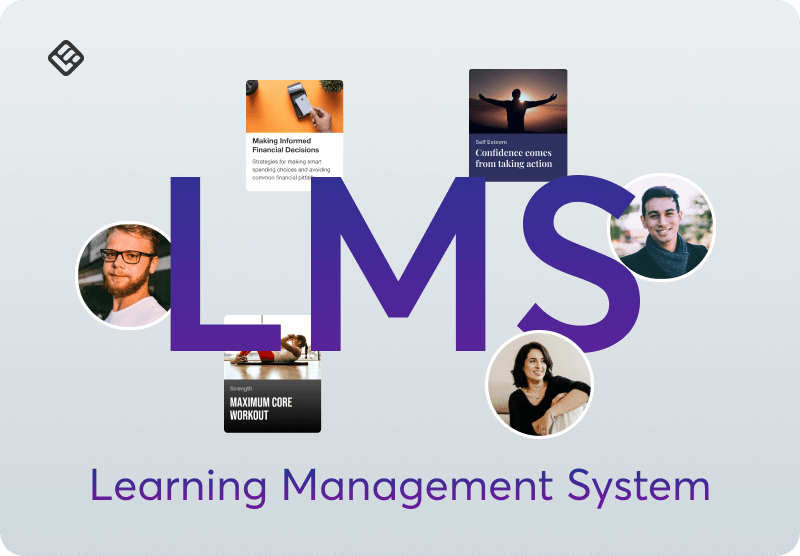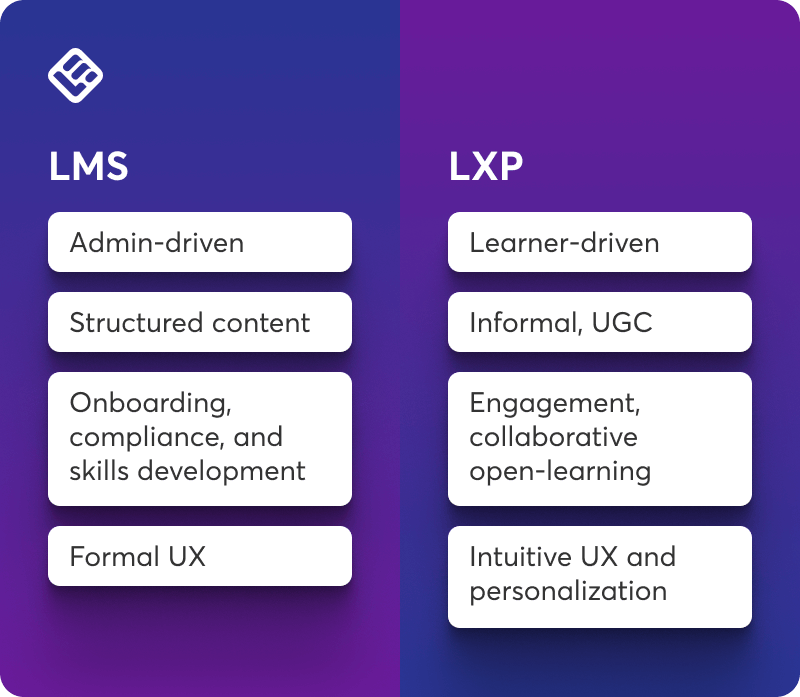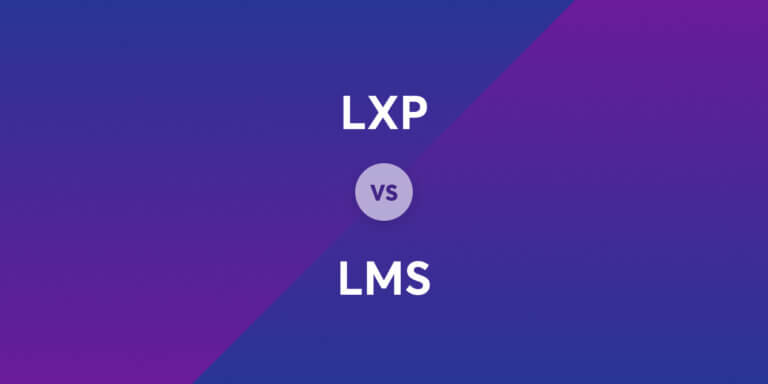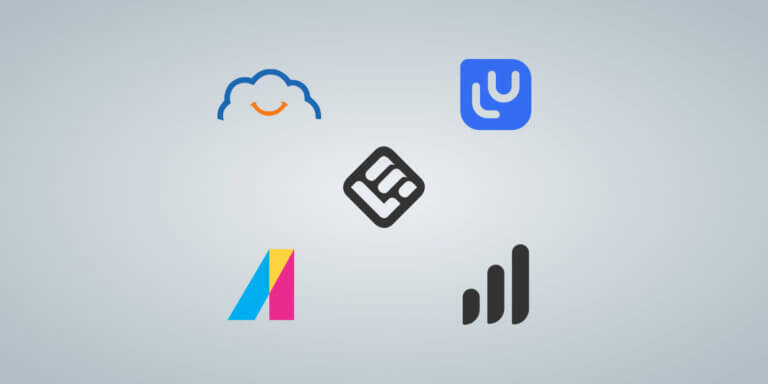Table of Contents
Prepare yourself for a battle royale: LXP vs LMS.
Well, not really. They both ultimately are trying to promote learning and knowledge retention, but they’re as different as it gets.
Specifically, an LMS is your organized, driven administrative professor, feeding courses to learners so they can systematically cover every learning module they need. On the other end of the spectrum, the LXP is more of a laid-back, learner-centric guide that serves personalized content.
But if you’ve been seeing this question around – ‘what is LXP vs LMS’, know that you are not alone. Let’s explore more hard facts on the difference between LMS and LXP and see how you can use both with your workforce.
What is an LMS?

A learning management system (LMS) is a platform you use to create, manage, and track learning courses and training programs. It acts like a virtual course room where you can organize content, set up assignments, and assess learners in a single place.
It resembles traditional education since it’s structured, controlled by an administrator, and designed primarily for formal learning. Yet, most LMS tools were designed for use by businesses that need to assign learning, monitor progress, and compile reports.
Plus, some come with more out-of-the-box capabilities that distance them from boring, formal learning. More on that later, after we explore where you can best use a learning management system.
LMS uses in business
Most companies start using an LMS tool for a very specific use case, like wanting to upskill their workforce or ensure everyone is up-to-date with the latest advancements in the sector.
But the biggest gains that come out of a learning management system in the LMS vs LXP talk are the following.
Streamlining employee training and onboarding
An LMS improves onboarding by keeping employee training in a single place so you can cover everything from company policies to role-specific skills for new team members.
With automated course assignments, you can track training for each employee without having to manually review progress each time. For example, a retail chain store could set up an LMS that trains the protocols around customer service across locations to ensure their employees are being trained in the same way.
Ensuring compliance and tracking certifications
Is compliance a priority for you? Your LMS should be able to assign mandatory training to ensure compliance whenever new changes impact your industry. Automation comes in to automatically track progress.
If certifications are needed in this mix, an LMS will track certifications and set up automatic reminders for renewals. For example, healthcare companies can use an LMS to ensure staff has maintained training on HIPAA certifications while keeping detailed audits for regulators’ review.
💡Wagamama, an international food company, was able to transition its training successfully from another employee screen-based technology to LearnWorlds. By moving 50 courses to LearnWorlds, Wagamama standardized its training, added functionality across numerous job-role levels, and achieved an 89.6% conversion rate.
Boosting performance through continuous learning
An LMS can also promote continuous development. Just set up a course for specific skills or new frameworks in your industry. The right online learning platform will track progress and identify gaps. The best one will recommend personalized learning paths.
Want to develop your workspace culture and promote growth? A company in the tech sector could use an LMS to roll out pair programming workshops that improve team performance. Meanwhile, in the fitness space, different trainers could be paired up by your LMS to create training plans and courses together.
What is an LXP?

A learning experience platform (LXP) is another tool that helps you deliver online training but is more heavily focused on the user. What stands out about a learning experience platform in the LXP and LMS comparison is that it gives learners more personalized and engaging experiences.
Learning management systems, by contrast, are usually more rigid and formally structured, whereas an LXP feels like you’re watching your favorite TV show or hanging out with friends and learning at the same time. An LXP makes for a more unique learning ecosystem that often relies on gamification or user-based content recommendations with the help of AI.
LXP uses in business
As we’re debating personalized learning with LXP vs structured training with LMS, LXPs play a solid role too. You can use them to create personalized learning experiences for your learners, enhance the collaboration between them, and encourage self-directed learning.
Personalized learning experiences for employees
The main reason learning experience platforms were built in the first place was to provide personalized content where standardized LMS learning failed. LXPs today rely on AI to recommend courses, podcasts, or articles based on the employee’s role, interests, and goals.
For example, a marketing manager might be served recommendations for webinars on marketing strategy development if they’re planning on taking on new responsibilities, scaling into a new market, or hiring more people.
LMS platforms still have a role to play in managing compliance training, certifications, and credentials. The future will likely see more coexistence and integration between LMS and LXP platforms, with LMS handling compliance and credentials while LXPs own the day-to-day learning experience. But without a doubt, the learner-centric and consumerized approach of LXPs is reshaping corporate learning technology.
Encouraging collaboration and knowledge-sharing
LXPs make for stronger social learning. You’ll see the best results if you plan on creating courses that rely on communities where employees can share insights, find learning materials, and make learning buddies.
User-generated content or discussion boards play a huge part here in building that ideal collaborative environment. When using LXPs it’s also best to think about how you can bring different individuals into the same learning paths and objectives as opposed to having them stick to a course independently.
A sales team can collaborate when learning by sharing effective pitch strategies or lessons learned from previous calls. In the same LXP, they could also start building a collaborative knowledge repository employees could use to refine their pitch. This fixes any knowledge gaps and prevents hurdles in succession planning.
Empowering self-directed skill development
LXPs also stand out in the learning experience platform vs learning management system debate because you can use them to encourage employees. By allowing them to discover skills on their own time and at their own pace, you won’t be putting pressure on them. This way, learning is no longer a burden.
LXPs also allow employees to choose which course or certificate piques their interest. This sense of ownership drives employee motivation and lets the learner take the initiative this time.
This does require a great deal of trust from managers, though. So let’s see where the difference between LMS and LXP becomes noticeable.
The way we learn today is no longer linear or one-size-fits-all. It’s dynamic, personal, and ongoing. LXPs are designed with that reality in mind. They make learning feel more like a conversation instead of a lecture, and that shift alone creates a huge impact. Rather than being told what to know, learners are encouraged to explore topics that resonate with them, reflect on how it applies to their roles, and revisit material when it’s relevant to their growth.
LXP vs LMS: What are the key differences?

Both LXP features vs LMS features are different when it comes to how a business approaches learning, how they deliver training, and what the final learning experience is.
Below, we go over the key LMS LXP differences.
Learning approach: structured vs. flexible
I’ve already mentioned how structured and formal LMS tools tend to be. This isn’t a bad thing, though. It’s simply an option if you prefer to follow a top-down model similar to a traditional classroom setup.
With structured learning, you’re delivering predetermined courses with formalized modules and timelines. These are actually great options for compliance training or certification-based courses.
LXPs fit better in teams looking for agile and flexible learning. They give learners more room to explore through self-paced learning, controlling what courses they want to learn based on needs and goals.
Surprisingly, this fits most types of teams, including small, cross-functional teams or distributed ones. That’s why most of these teams actually use a mix of LMS and LXP training to match different learning needs.
Content delivery: assigned modules vs. curated content
An LMS gives your workforce pre-assigned modules they need to cover one step at a time. The system allows managers to assign specific courses when an employee needs them the most and gradually track their progress. The latter part is particularly important as it makes it easier for managers to share feedback and adjust learning paths based on results.
An LXP pulls content from various sources, including video, articles, and podcasts, based on the learner’s profile. AI algorithms, instead of the manager, are the ones analyzing progress and drawing this content from both internal and external libraries.
User experience: administrator-driven vs. learner-centric
An LMS should always have an administrator. Depending on how big your team is, this can be a team lead, operations manager, L&D driver, or HR expert. They’re the ones handling course assignments, progress tracking, and reporting.
LXPs are better suited if you don’t want or don’t have the time to control everything in detail. With a learning experience platform, you’re essentially putting learning on autopilot and allowing your learners to choose their training experience. Such a learner-centric perspective works better if you have teammates who prefer to discover content on their own and discuss learning with their peers for a more collaborative learning experience.
LXP vs LMS: Which do you need?
From the comparison above, you might have noticed it’s not the LMS LXP debate that’s important. While looking into both more closely, you should focus on when you need each and where it’s best to use both at the same time.
Identifying your business training goals
LMS tools were traditionally used for intentional, mandatory, or structured learning where the learning objectives weren’t negotiable. If you need your employees to comply with a new directive, learn a framework by heart, or earn a certificate, an LMS is a must.
For example, a manufacturing company with multiple factories should choose an LMS to assign work safety courses and track mandatory OSHA compliance.
LXP tools come later when you want to promote continuous learning and competency development. They’re also handy if your main business outcomes include innovation, employee upskilling, or career progression, since they’re more flexible.
A startup that wants to keep developers up-to-date on current trends in machine learning will use an LXP to continuously curate learning materials on the topic. Depending on the industry, they’ll want to use both LMS and LXP so they can cover compliance, too, with an LMS.
Understanding your employees’ learning preferences
Nothing makes learning more effective than listening to what employees want. Let’s be real: Some will be happy with your classic structured learning environment because it’s clear and easy to follow.
An LXP is more appealing to self-starters or employees who prefer learning through short bits of content as opposed to large modules. How socially involved your team wants to be also plays into the choice. For instance, a marketing team might enjoy an LXP’s customized SEO webinars or tips from peers.
Still, you’ll want to get your team’s feedback before you pick a single option. In some cases, you might just have to deliver learning exactly the way every individual in your workforce prefers, even if that means the use of both LMS and LXP.
Choosing the right solution for long-term growth
Ongoing development in regulated industries or jobs with consistent skill needs calls for an LMS. The way learning management systems are built (at least for now) gives you more predictability and scalability.
Still, some of them are not so good if you need to respond to changes quickly. And this is something more companies have to deal with.
LXPs support dynamic industries to keep employees agile and curious. By focusing on personalization and collaboration, you can build a lasting learning culture.
What’s important is that most modern LMS tools come with LXP functionalities. So the choice isn’t really a choice.
Where to next with deciding on a learning platform?
This article gave an answer to the question of what is LXP vs LMS covering the key differences between the two learning systems. Now, the learning platform decision is yours, and if you ask me, it is quite simple. Picking between an LMS and an LXP doesn’t have to happen. You can use both when you need a mix of compliance training and self-paced microlearning.
It all comes down to what your goals are and how your employees prefer to add to their skills and knowledge. Many organizations are gradually switching towards a blended approach for both the structured methodical approach as well as some self-directed learner preferences.
If you’re ready to deliver training, explore LearnWorlds to see how you can get the best of both an LMS and an LXP in a single learning platform. No need to pick.

Alexandra Cote
Alexandra Cote is a SaaS growth marketer and online instructor who's worked with dozens of brands in the MarTech, HR tech, and productivity space. She's also a strong supporter of staying happy at work and choosing a healthy career path.
FAQ
Everything you have ever wondered, but where too afraid to ask...




